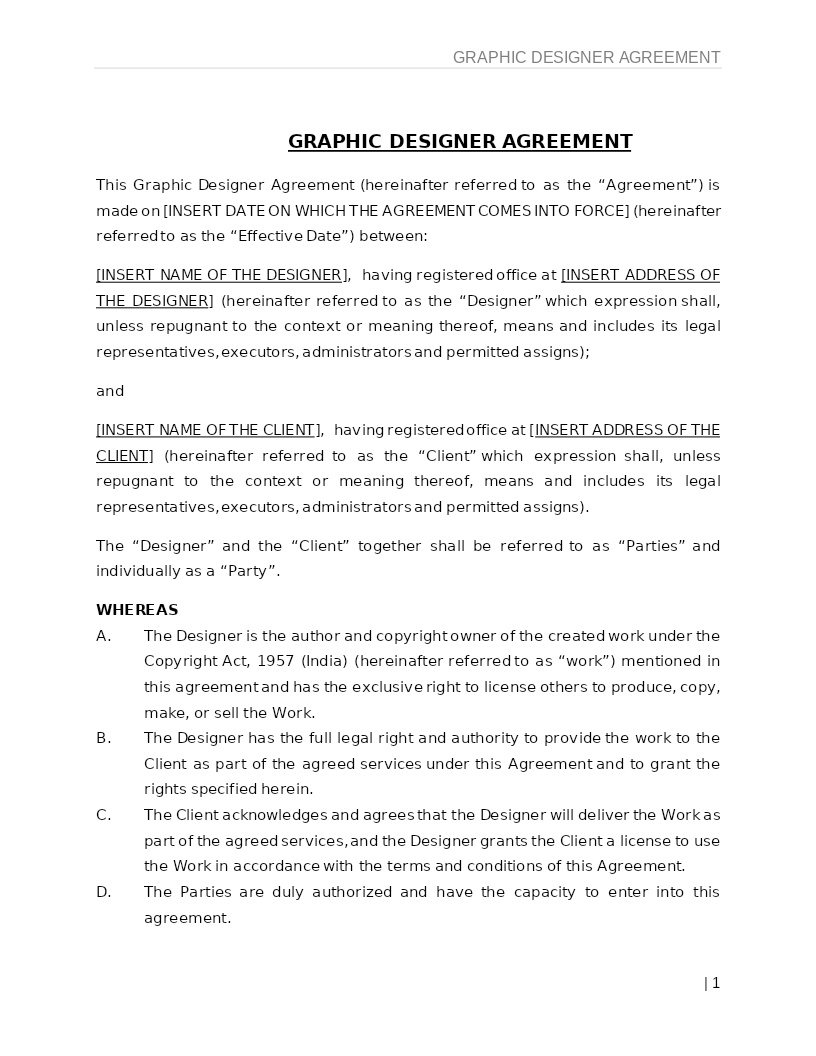
GRAPHIC DESIGNER AGREEMENT
How does it work?
1. Choose this template
Start by clicking on "Fill out the template"
2. Complete the document
Answer a few questions and your document is created automatically.
3. Save - Print
Your document is ready! You will receive it in Word and PDF formats. You will be able to modify it.
What is a Graphic Designer Agreement?
A Graphic Designer Agreement is a legally binding contract between a Client and a Graphic Designer (individual freelancer, agency, or studio) that defines the terms under which creative design services will be provided. It establishes the scope of work, payment terms, intellectual property ownership, timelines, and confidentiality obligations governing the professional relationship.
This agreement protects the interests of both parties by ensuring clarity over project expectations, creative ownership, and commercial use rights of the designs produced.
A well-drafted Graphic Designer Agreement provides a structured framework for collaboration, prevents disputes related to payment or intellectual property, and promotes transparency throughout the design process.
This template is:
• Lawyer-drafted and legally neutral, suitable for use across multiple jurisdictions.
• Applicable to freelance, contractual, or agency-based design engagements.
• Covers scope of services, timelines, payment terms, ownership, and confidentiality.
• Customizable for branding, digital, print, web, or multimedia design projects.
Key Features of a Graphic Designer Agreement
1. Parties to the Agreement
Identifies the contracting parties the Client (individual, company, or organization) and the Graphic Designer (independent contractor or agency) with their legal names, business details, and contact information.
2. Scope of Work
Defines the specific design services to be performed, including deliverables such as logos, illustrations, brand assets, website graphics, social media materials, or marketing collateral.
The scope may be detailed in a Schedule or Statement of Work (SOW) attached to the agreement.
3. Project Timeline and Deliverables
Specifies the deadlines for drafts, revisions, and final submissions, along with milestones for feedback or approval. This ensures structured project management and accountability.
4. Compensation and Payment Terms
Outlines the total project fee or hourly rate, mode of payment, and billing frequency (e.g., milestone-based, upfront deposit, or upon delivery).
It may include provisions for late payments, additional revisions, or project scope changes requiring extra compensation.
5. Ownership and Intellectual Property Rights
Clarifies the transfer of intellectual property (IP) rights from the Graphic Designer to the Client upon full payment.
• Before payment, all designs remain the property of the Designer.
• After payment, ownership of the final deliverables passes to the Client.
The Designer may retain limited rights for self-promotion or portfolio use unless otherwise agreed in writing.
6. Revisions and Approval Process
Defines the number of revisions included in the fee and the process for Client feedback. Additional revisions or changes beyond agreed rounds may incur additional charges.
7. Confidentiality and Data Protection
Requires both parties to maintain confidentiality over proprietary information, brand strategies, and client data shared during the engagement.
The clause may reference applicable data protection frameworks (e.g., GDPR, DPDP Act 2023).
8. Use of Third-Party Materials
Ensures that any third-party fonts, stock images, or creative assets used in the designs are properly licensed, and specifies who bears responsibility for licensing costs.
9. Independent Contractor Relationship
States that the Graphic Designer is an independent contractor not an employee and is solely responsible for their own taxes, insurance, and legal compliance.
10. Termination of Agreement
Defines the conditions under which either party may terminate the contract, such as non-payment, non-performance, or mutual consent. The clause also explains the Client’s obligation to pay for completed work and the Designer’s duty to deliver work done up to the termination date.
11. Warranties and Liability
Confirms that all work is original and does not infringe any third-party rights.
Limits liability for indirect losses while ensuring accountability for breaches of confidentiality or IP infringement.
12. Dispute Resolution and Governing Law
Provides a neutral mechanism for resolving disputes typically through mediation or arbitration and specifies the governing law and jurisdiction, adaptable for domestic or cross-border projects.
Why You Need a Graphic Designer Agreement?
• Establishes clear expectations for project scope, deadlines, and payments.
• Protects intellectual property rights of both Client and Designer.
• Prevents disputes over revisions, usage rights, or payment delays.
• Defines ownership and permitted usage of creative materials.
• Ensures confidentiality and data protection during collaboration.
• Supports professional accountability and long-term creative partnerships.
FAQs on Graphic Designer Agreements
Q1: Is a Graphic Designer Agreement legally binding?
Yes. Once signed by both parties, it becomes a legally enforceable contract under general contract law principles.
Q2: Who owns the designs after project completion?
Unless otherwise agreed, ownership of the final deliverables transfers to the Client only after full payment. The Designer may retain rights to preliminary drafts or portfolio use.
Q3: Can a Graphic Designer use third-party materials in their work?
Yes, but only with appropriate licenses. The agreement should clarify whether the Client or Designer will obtain and pay for these licenses.
Q4: Can the agreement be executed electronically?
Yes. It can be signed electronically under global e-signature laws (e.g., the UNCITRAL Model Law, E-SIGN Act, or IT Act 2000).
Q5: What happens if the Client requests additional changes or delays approval?
Additional revisions beyond the agreed limit may attract extra fees, and extended timelines may adjust delivery schedules accordingly.
Q6: What if either party breaches the agreement?
The non-breaching party may terminate the contract and seek remedies such as payment recovery, damages, or injunctive relief, as per the governing law.
Related Templates You May Need
• Consulting Services Agreement
• Non-Disclosure Agreement (NDA)
• Intellectual Property (IP) Assignment Agreement